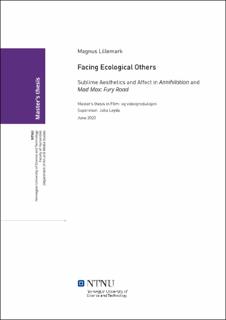| dc.contributor.advisor | Julia Leyda | |
| dc.contributor.author | Lillemark, Magnus | |
| dc.date.accessioned | 2021-09-14T16:06:58Z | |
| dc.date.available | 2021-09-14T16:06:58Z | |
| dc.date.issued | 2020 | |
| dc.identifier | no.ntnu:inspera:53759382:36612465 | |
| dc.identifier.uri | https://hdl.handle.net/11250/2776594 | |
| dc.description.abstract | Kinopublikumets økende kunnskap og bekymringsnivå rundt klimaendringer utfordrer filmskapere av klimafiksjon. Den klassiske Hollywood-katastrofe/eventyrfortellingen kan for den moderne betrakteren virke naiv eller å minimalisere et tema som det vitenskapelige samfunnet er enig i er alvorlig. Dette påvirker valget av visuell og affektiv tilnærming som klimavennlige filmskapere kan ta når de presenterer møter med naturlige og unaturlige fenomener eller lifsformer berørt av klimaendringer og traumer. Denne oppgaven tar for seg de estetiske og emosjonelle dimensjonene i slike filmatiske konfrontasjoner i et forsøk på å isolere deres dramatiske funksjon og budskap. For å få innsikt i disse områdene, benytter denne studien nærlesninger og sammenligninger av et utvalg cli-fi-fortellinger, analysert gjennom linsen til eksisterende teoretiske felt i estetikk, affect theory og andre økologisk tenkende områder innen humaniora. Disse lesningene og analysene avdekker tilnærminger og teknikker som vektlegger dramatiseringen av karakterenes emosjonelle indre liv, kombinert med en tendens til å bruke sublim og gotisk estetikk. Man finner at de affektive ladningene til disse filmene sentrerer seg rundt tradisjonelt forstått negative følelser som skyld og sorg, mens man fremdeles legger til rette for katartiske budskap om hvordan man kan komme videre gjennom menneske til ikke-menneskelig sameksistens. | |
| dc.description.abstract | The cinema audience’s increasing knowledge and level of concern around climate change challenges filmmakers of climate fiction. The classic Hollywood catastrophe/adventure narrative can to the modern viewer appear naïve or to be making light of a topic that the scientific community agree is severe. This affects the choice of visual and affective approach climate-aware filmmakers can take when presenting encounters with natural and unnatural phenomena or entities affected by climate change and trauma. This paper considers the aesthetic and emotional dimensions in these sorts of cinematic confrontations in an attempt to isolate their dramatic function and message. To gain insights into these areas, this study utilizes close readings and comparisons of a selection of cli-fi narratives, analyzed through the lens of existing theoretical fields in aesthetics, affect theory and other ecologically minded areas within the humanities. These readings and analyses reveal approaches and techniques that foreground the dramatization of the emotional inner life of characters, coupled with a tendency towards employing sublime and gothic aesthetics. One finds the affective pull of these films to center on traditionally negatively charged emotions of guilt and mourning, while still facilitating cathartic messages of how to move forward in human to non-human coexistence. | |
| dc.language | | |
| dc.publisher | NTNU | |
| dc.title | Facing Ecological Others - Sublime Aesthetics and Affect in Annihilation and Mad Max: Fury Road | |
| dc.type | Master thesis | |
